Saltzman B. (editor) Anomalous Atmospheric Flows and Blocking
Подождите немного. Документ загружается.

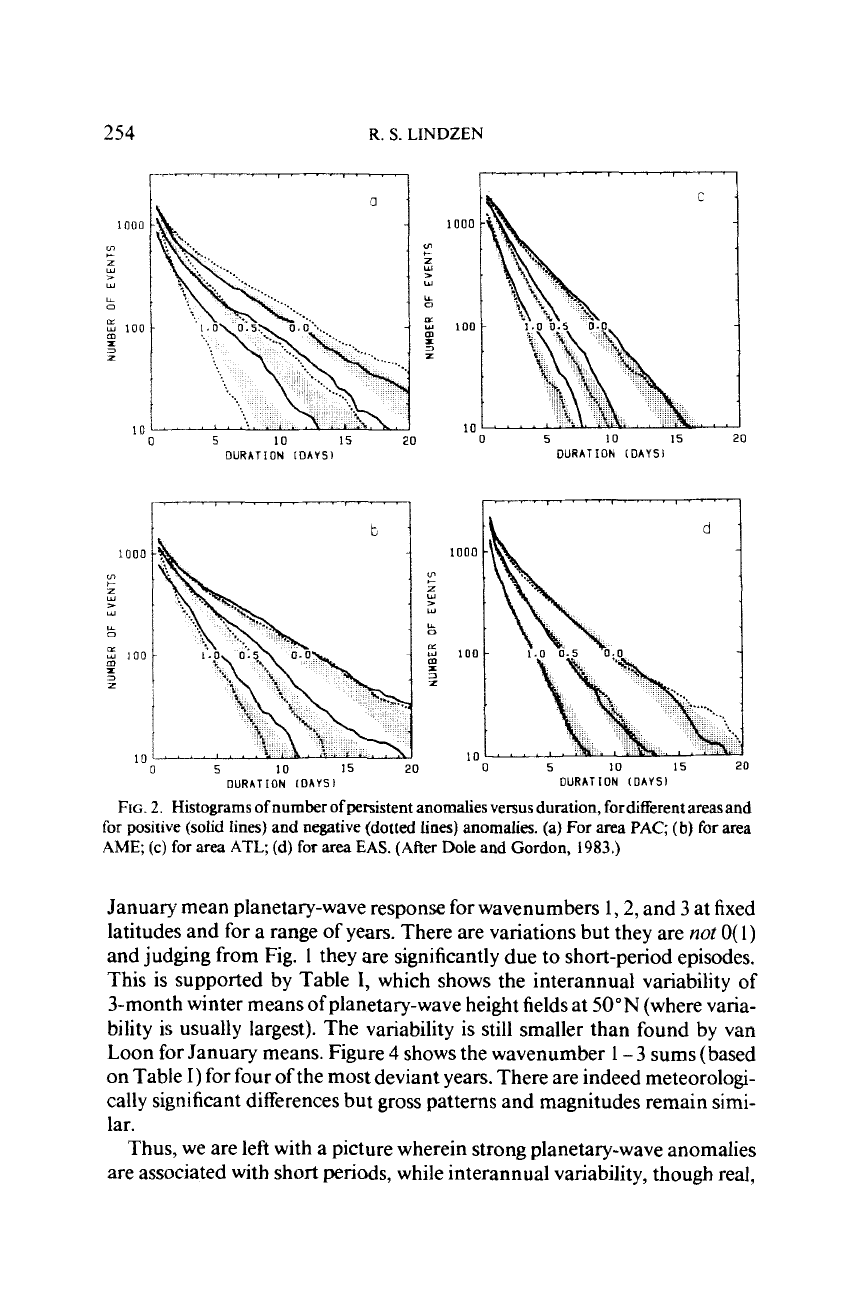
254
R.
S.
LINDZEN
ID00
I000
VI
r
t-
z
z
w
w
>
>
w
w
LA
LL
0
0
w
100
m
m
3
3
z z
07
=
:
100
I
10
0
5
10
15
20
0
5
10
15
20
10
DURATION
[DAYS1
DURATION
(DAYS1
1000
m
+
z
w
>
w
Y
D
6
100
m
T
3
z
10
1
I'"""'""''"''~I
1000
r
z
Y
>
w
Y
0
5
100
m
z)
10
5
10
15
20
0
5
10
15
20
OURATION
LOAYS1
OURATION
(DAYS)
FIG.
2.
Histograms
of
number
of
persistent anomalies versus duration,
for
different areas and
for
posirive
(solid
Iines)
and
negative (dotted
lines)
anomalies. (a) For area
PAC;
(b)
for
area
AME;
(c)
for
area
ATL;
(d)
for
area
EAS.
(ARer
Dole
and Gordon,
1983.)
January mean planetary-wave response
for
wavenumbers
1,2,
and
3
at fixed
latitudes and for a range of years. There are variations but they are
not
O(
1)
and judging from
Fig.
1
they are significantly due to short-period episodes.
This
is
supported
by
Table
I,
which shows the interannual variability
of
3-month winter means of planetary-wave height fields at
50"N
(where varia-
bility is usually largest). The variability
is
still smaller than found by van
Loon for January means. Figure
4
shows the wavenumber
1
-
3
sums (based
on Table
I)
for four of the most deviant years. There are indeed meteorologi-
cally significant differences but
gross
patterns and magnitudes remain
simi-
lar.
Thus, we are left with a picture wherein strong planetary-wave anomalies
are associated with short periods, while interannual variability, though real,
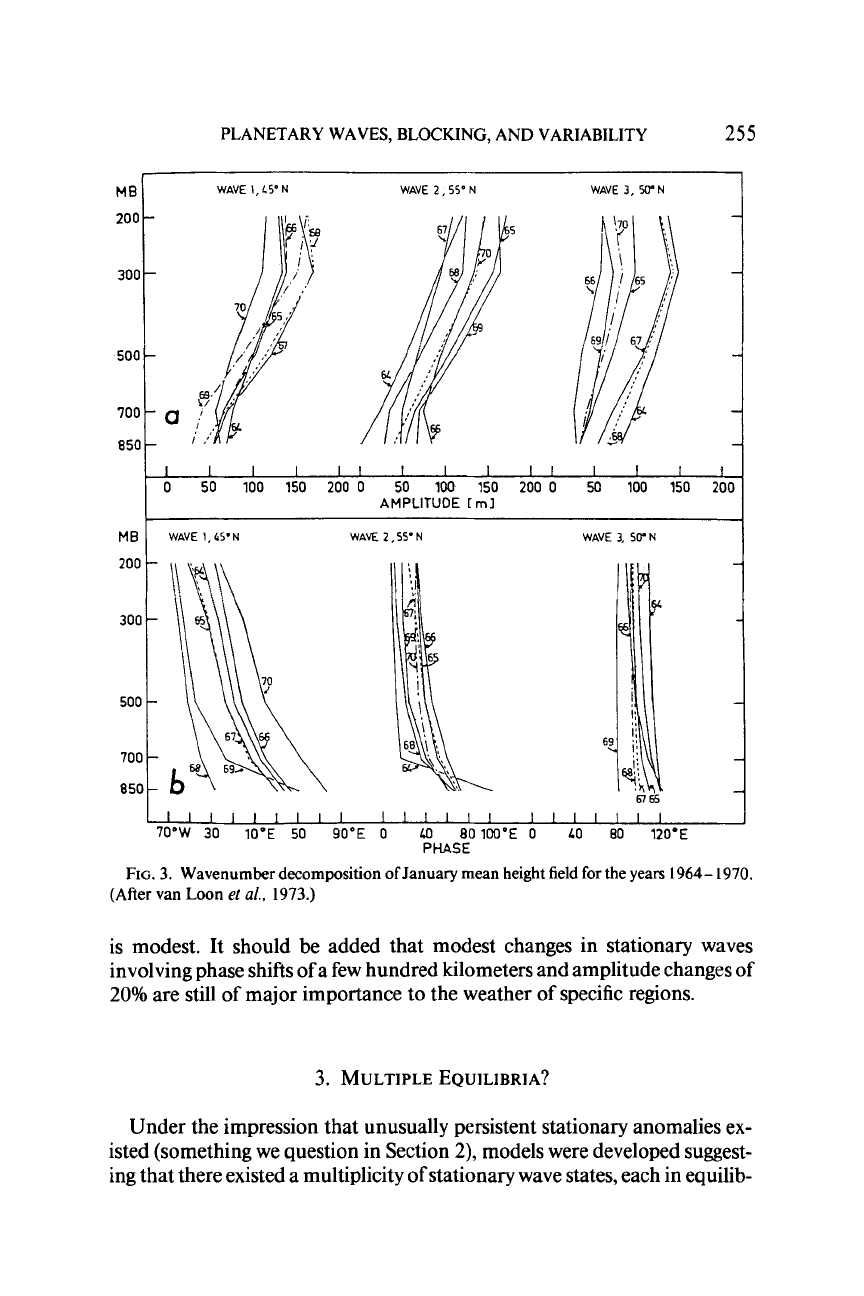
PLANETARY WAVES, BLOCKING, AND VARIABILITY
255
200
300
500
700
850
WAVE
I,
L5'N
WAVE
2,55'
N
WAVE
3,
WN
MB
-
-
-
b.
-
c]
;
i
,,'
-
I
I
I
I
I1
I
I
I
II
I
I
I
1
0
50
100
150
200
0
50
100
150
200
0
50
100
150
20
AMPLITUDE
[
ml
ME
WAVE
1,
65"
WAVE
2,SS'
N
WAVE
3,
SVN
6765
IIIIIIIII
IIIIII
IIIIIII
70'W
30
10'E
50
90"E
0
LO
80lW'E
0
LO
80
120'E
PHASE
FIG.
3.
Wavenumber
decomposition
ofJanuary mean height field for the years
1964-
1970.
(After van
Loon
el
al.,
1973.)
is modest. It should be added that modest changes in stationary waves
involving phase shifts
of
a few hundred kilometers and amplitude changes of
20%
are still
of
major importance to the weather
of
specific regions.
3.
MULTIPLE EQUILIBRIA?
Under the impression that unusually persistent stationary anomalies ex-
isted (something we question in Section
2),
models were developed suggest-
ing that there existed a multiplicity
of
stationary wave states, each in equilib-
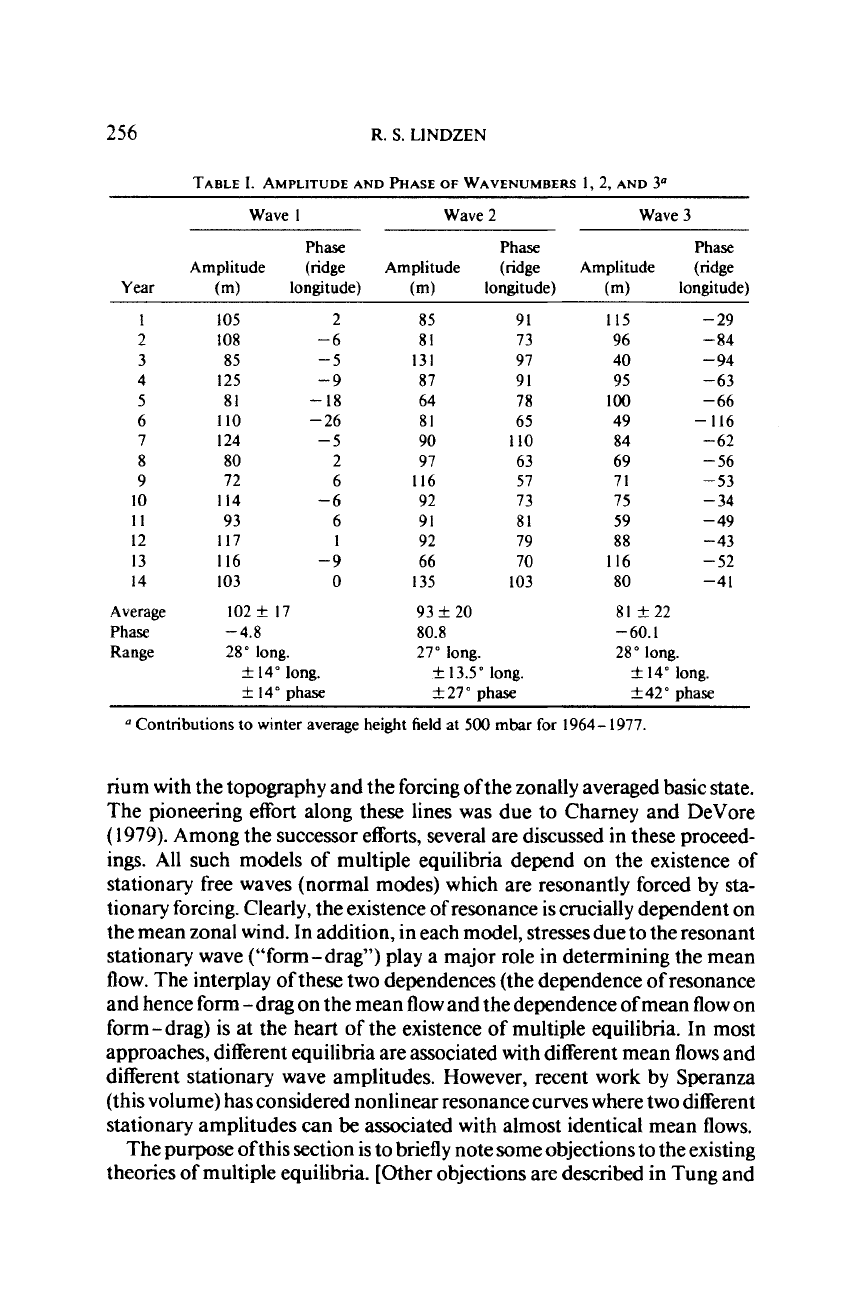
256
R.
S.
LlNDZEN
TABLE
1.
AMPLITUDE
AND
PHASE
OF
WAVENUMBERS
1,2,
AND
3"
Wave
I
Wave
2
Wave
3
Phase Phase Phase
Amplitude (ridge Amplitude (ridge Amplitude (ridge
Year
(m)
longitude)
(m)
longitude)
(m)
longitude)
1
2
3
4
5
6
7
8
9
10
11
12
13
14
Average
Phase
105 2
t
08
-6
85
-5
125
-9
81
-
18
110
-
26
I24
-5
80 2
72
6
I14 -6
93
6
1
I7
1
1
I6
-9
103
0
102f 17
-4.8
85
81
131
87
64
81
90
97
I16
92
91
92
66
I35
93
*
20
80.8
91
73
97
91
78
65
110
63
57
73
81
79
70
103
115
96
40
95
100
49
84
69
71
75
59
88
I16
80
81 f22
-
60.1
-
29
-
84
-
94
-
63
-
66
-116
-
62
-
56
-
53
-
34
-
49
-
43
-
52
-41
Range
28"
long.
27"
long.
28"
long.
f
14"
long.
f
13.5"
long.
f
14"
long.
f
14"
phase
+27"
phase
f42"
phase
a
Contributions
to
winter average height field at
500
mbar
for
1964- 1977.
rium with the topography and the forcing ofthe zonally averaged basic state.
The pioneering effort along these lines was due to Charney and DeVore
(1979).
Among the successor efforts, several are discussed in these proceed-
ings.
All
such models of multiple equilibria depend on the existence of
stationary free waves (normal modes) which are resonantly forced by sta-
tionary forcing. Clearly, the existence of resonance is crucially dependent on
the mean zonal wind. In addition, in each model, stresses due to the resonant
stationary wave ("form-drag") play a major role in determining the mean
flow. The interplay of these
two
dependences (the dependence of resonance
and hence form -drag on the mean flow and the dependence of mean flow
on
form -drag) is at the heart of the existence of multiple equilibria. In most
approaches, different equilibria are associated with different mean flows and
different stationary wave amplitudes. However, recent work by Speranza
(this volume) has considered nonlinear resonance curves where two different
stationary amplitudes
can
be
associated with almost identical mean flows.
The purpose ofthis section is to briefly note some objections
to
the existing
theories of multiple equilibria. [Other objections are described in Tung and
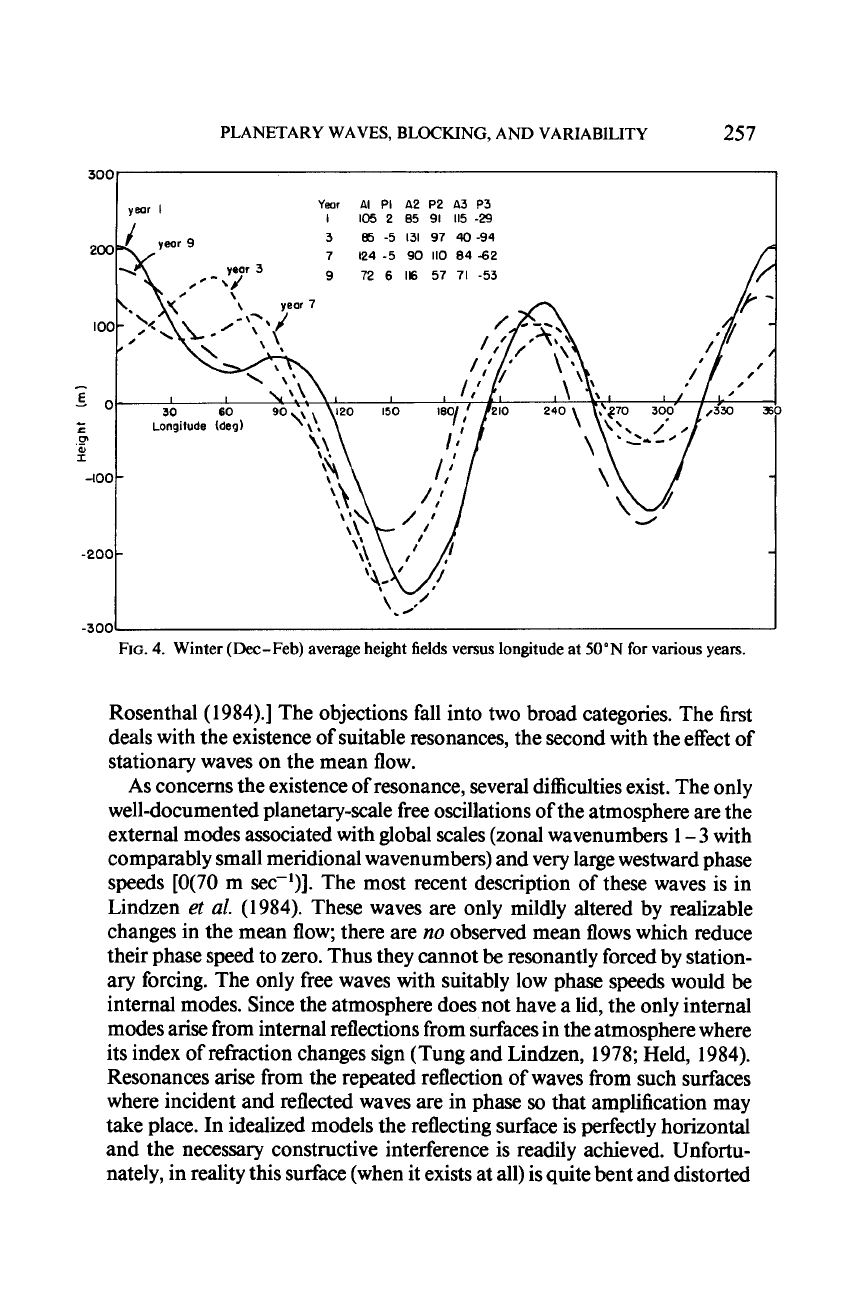
PLANETARY WAVES, BLOCKING, AND VARIABILITY
257
300t
I
YBor
A1
PI A2
P2
A3 P3
I
105
2
85 91 115
-29
3
85
-5 131
97
40
-94
7
124 -5
90
I10
84
62
9
72
6
116
57
71
-53
-100
-
-200-
-
-300-
FIG.
4.
Winter (Dec-Feb) average height fields versus longitude at 50”
for
various years.
Rosenthal(1984).] The objections fall into two broad categories. The first
deals with the existence of suitable resonances, the second with the effect of
stationary waves on the mean flow.
As
concerns the existence of resonance, several difficulties exist. The only
well-documented planetary-scale free oscillations of the atmosphere are the
external modes associated with global scales (zonal wavenumbers
1
-
3
with
comparably small meridional wavenumbers) and very large westward phase
speeds [0(70 m sec-’)I. The most recent description of these waves is in
Lindzen
et
al.
(1984). These waves are only mildly altered by realizable
changes in the mean flow; there are
no
observed mean flows which reduce
their phase speed to zero. Thus they cannot be resonantly forced by station-
ary forcing. The only free waves with suitably low phase speeds would be
internal modes. Since the atmosphere does not have a lid, the only internal
modes arise from internal reflections from surfaces in the atmosphere where
its index of refraction changes sign (Tung and Lindzen, 1978; Held, 1984).
Resonances arise from the repeated reflection of waves from such surfaces
where incident and reflected waves are in phase
so
that amplification may
take place. In idealized models the reflecting surface is perfectly horizontal
and the necessary constructive interference is readily achieved. Unfortu-
nately, in reality this surface (when it exists at all) is quite bent and distorted
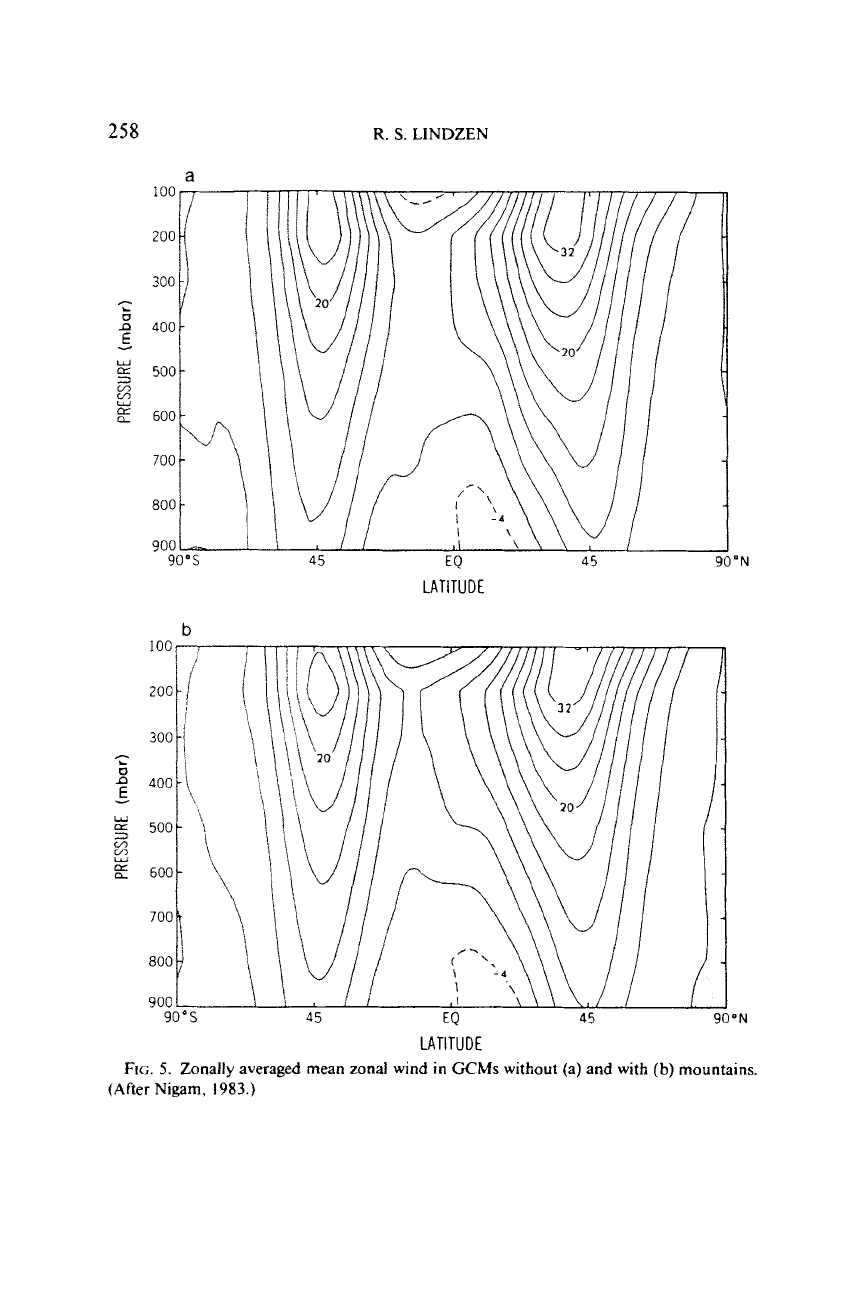
258
a
R.
S.
LINDZEN
LATITUDE
b
LATITUDE
FIG.
5.
Zonally averaged
mean
zonal wind
in
GCMs
without (a) and
with
(b)
mountains.
(After
Nigam.
1983.)

PLANETARY WAVES, BLOCKING, AND VARIABILITY
259
and reflected waves do not coincide with incident waves; resonant amplifi-
cation, therefore, is profoundly limited. A clear example of this effect is given
by Lindzen and Hong
(1
974). The situation is rendered even more negative
by the fact that stationary resonant modes would also encounter zero wind
surfaces. Although it has been argued that nonlinearity can lead to reflection
at such surfaces (Tung, 1979), it is also true that in the neighborhood of such
surfaces damping becomes very important and is inimical to resonance.
Even normal damping will severely restrict resonance. It has recently been
suggested by McIntyre and Palmer (1984) that wave steepening near such
surfaces leads to irreversible mixing
so
that the damping limit may, in fact, be
intrinsic. [However,
P.
Killworth and M.
E.
McIntyre (private communica-
tion) recently noted that this may not be uniquely associated with wave
absorption.]
For all the above reasons one may reasonably conclude that the resonance
called for in multiple-equilibria theories is unlikely under realistic circum-
stances. This view is supported by the recent work of Jacqmin and Lindzen
(
1984) wherein stratospheric wind configurations suggested by Tung and
Lindzen
(1
979) as favorable for resonance were used, and no anomalous
tropospheric response was obtained.
We turn, finally, to the influence of stationary waves on the mean flow
-
an influence essential to most multiple-equilibria theories. Nigam
(
1983)
recently ran a general circulation model (GCM) at Geophysical Fluid
Dy-
namics Laboratory (GFDL), where zonal wind distributions were calculated
in models with and without mountains (the major forcers of stationary
waves at midlatitudes). His results are shown in Fig.
5.
Clearly the zonal
winds (except at the surface) are almost identical.
Thus on both essential grounds, there seems to be little theoretical support
for the possibility of proposed multiple equilibria.
4. TELECONNECTIONS
-
THE TROPICAL CONNECTION?
In the search for a means to anticipate years with anomalous stationary
wave patterns, teleconnections have played a prominent role. The term was
introduced by J. Namias to describe the apparent correlation of weather at
remote points. In recent years the idea has been closely associated with the
notion that tropical heating plays a major role in forcing high-latitude sta-
tionary waves (Wallace and Gutzler, 198
1
;
Horel and Wallace, 198
1).
Figure
6
shows the Pacific-North American (PNA) pattern from Wallace and
Gutzler
(1
98
1)
which is found to account for about 18% of the planetary-
wave variance. Clearly, this is not a dominant factor. Moreover, the omis-
sion
of
the tropical part of the PNA pattern would not greatly reduce the
variance it accounts for. Despite this, great emphasis has been placed on this
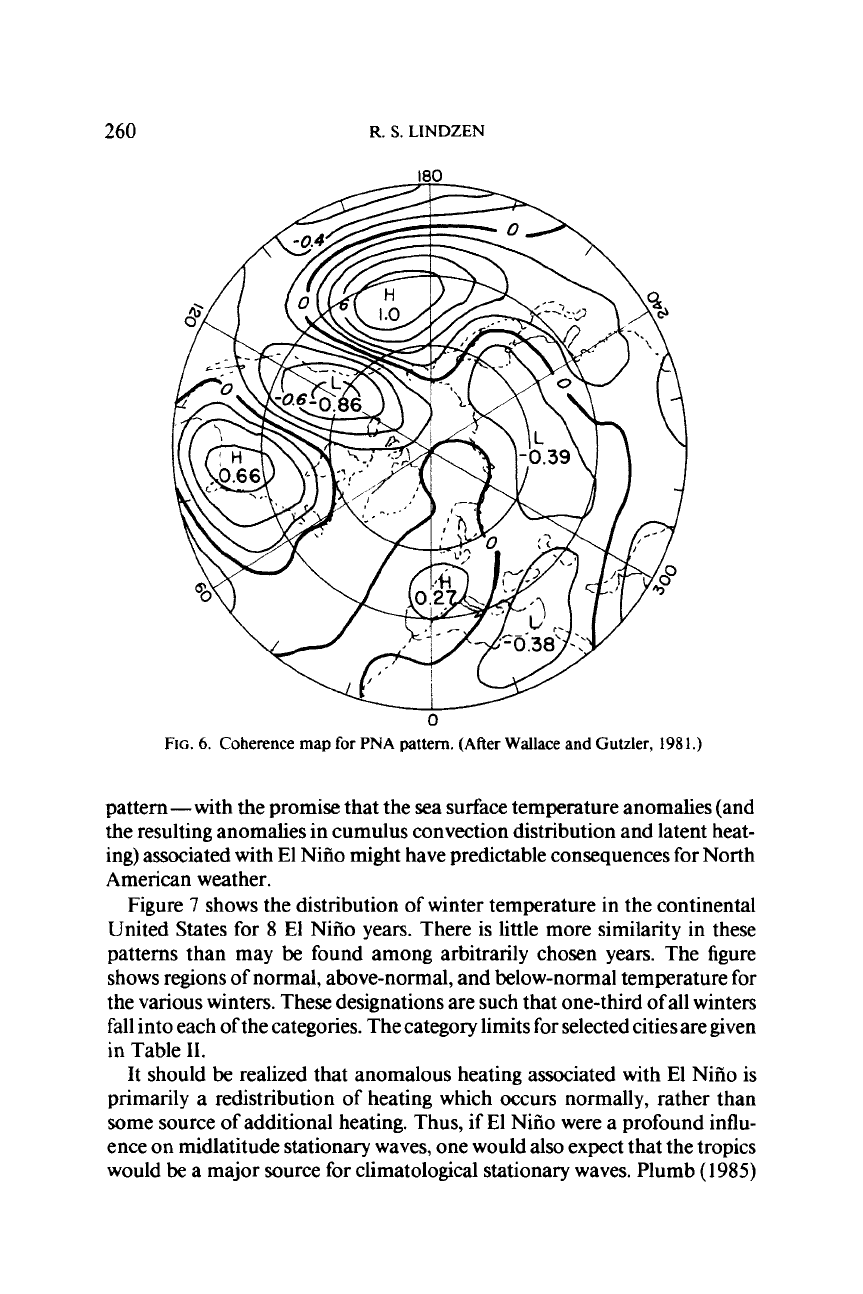
260
R.
S.
LINDZEN
FIG.
6.
Coherence
map
for
PNA
pattern.
(AAer
Wallace
and
Gutzler,
198
1
.)
pattern -with the promise that the
sea
surface temperature anomalies (and
the resulting anomalies in cumulus convection distribution and latent heat-
ing) associated with El Niiio might have predictable consequences for North
American weather.
Figure
7
shows the distribution of winter temperature in the continental
United States for
8
El Nifio years. There is little more similarity in these
patterns than may be found among arbitrarily chosen years. The figure
shows regions of normal, above-normal, and below-normal temperature for
the various winters. These designations are such that one-third of all winters
fall into each of the categories. The category limits for selected cities are given
in Table
11.
It
should be realized that anomalous heating associated with El Niiio is
primarily a redistribution of heating which occurs normally, rather than
some source of additional heating. Thus, if El Niiio were a profound influ-
ence on midlatitude stationary waves, one would also expect that the tropics
would be a major source for climatological stationary waves. Plumb
(1985)

FIG.
7. Winter temperature pattern over North America
for
8
El
Niiio years. (From NWS
climate alert.)
TABLE
11.
WEATHER SERVICE CLASS LIMITS
FOR
90-DAY WINTER MEANS
~~~
Boston
New
York
City
Miami
New
Orleans
Des
Moines
Denver
Los
Angeles
San
Francisco-Oakland
Seattle
Great
Falls
30.9"
f
1.3"F
33.6"
f
1.3"F
67.8"
f
1.2"F
54.4"
f
1.9"F
22.8"
2
1.6"F
31.7"
f
15°F
55.3"
2
1.2"F
49.7"
f
1.O"F
40.2"
f
1.2"F
21.1"
*
2.9'F
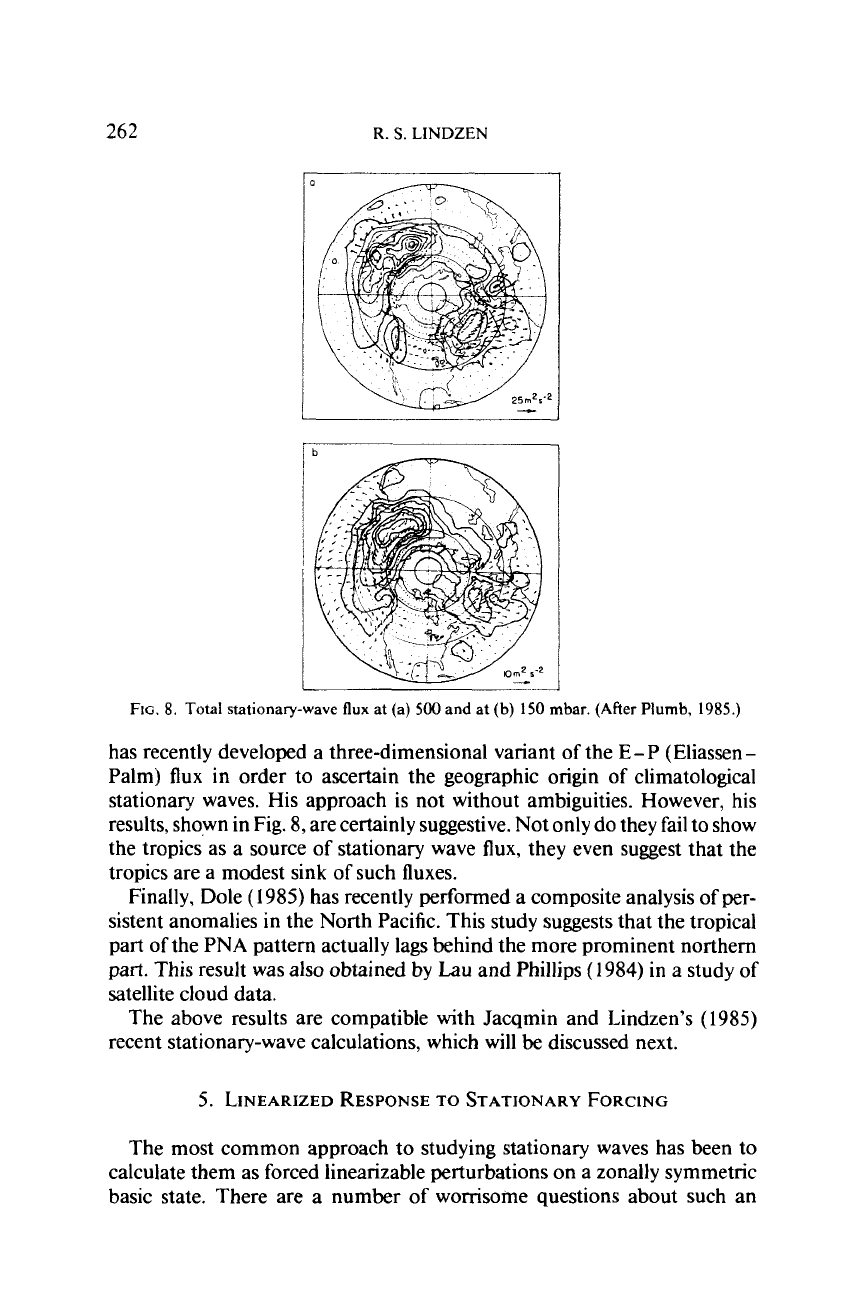
262
R.
S.
LINDZEN
FIG.
8.
Total
stationary-wave
flux
at (a)
500
and at
(b)
150
mbar.
(After
Plumb,
1985.)
has recently developed a three-dimensional variant of the
E-
P (Eliassen
-
Palm) flux in order to ascertain the geographic origin of climatological
stationary waves.
His
approach is not without ambiguities. However, his
results, shown in Fig.
8,
are certainly suggestive. Not only
do
they fail to show
the tropics as a source of stationary wave flux, they even suggest that the
tropics are a modest sink
of
such fluxes.
Finally, Dole
(1
985)
has
recently performed a composite analysis of per-
sistent anomalies in the North Pacific. This study suggests that the tropical
part
of
the PNA pattern actually lags behind the more prominent northern
part. This result was also obtained by
Lau
and Phillips
(
1984)
in a study
of
satellite cloud data.
The above results are compatible with Jacqmin and Lindzen’s
(1985)
recent stationary-wave calculations, which
will
be
discussed next.
5.
LINEARIZED
RESPONSE
TO
STATIONARY
FORCING
The most common approach to studying stationary waves has been to
calculate them as forced linearizable perturbations on a zonally symmetric
basic state. There are a number of womsome questions about such an
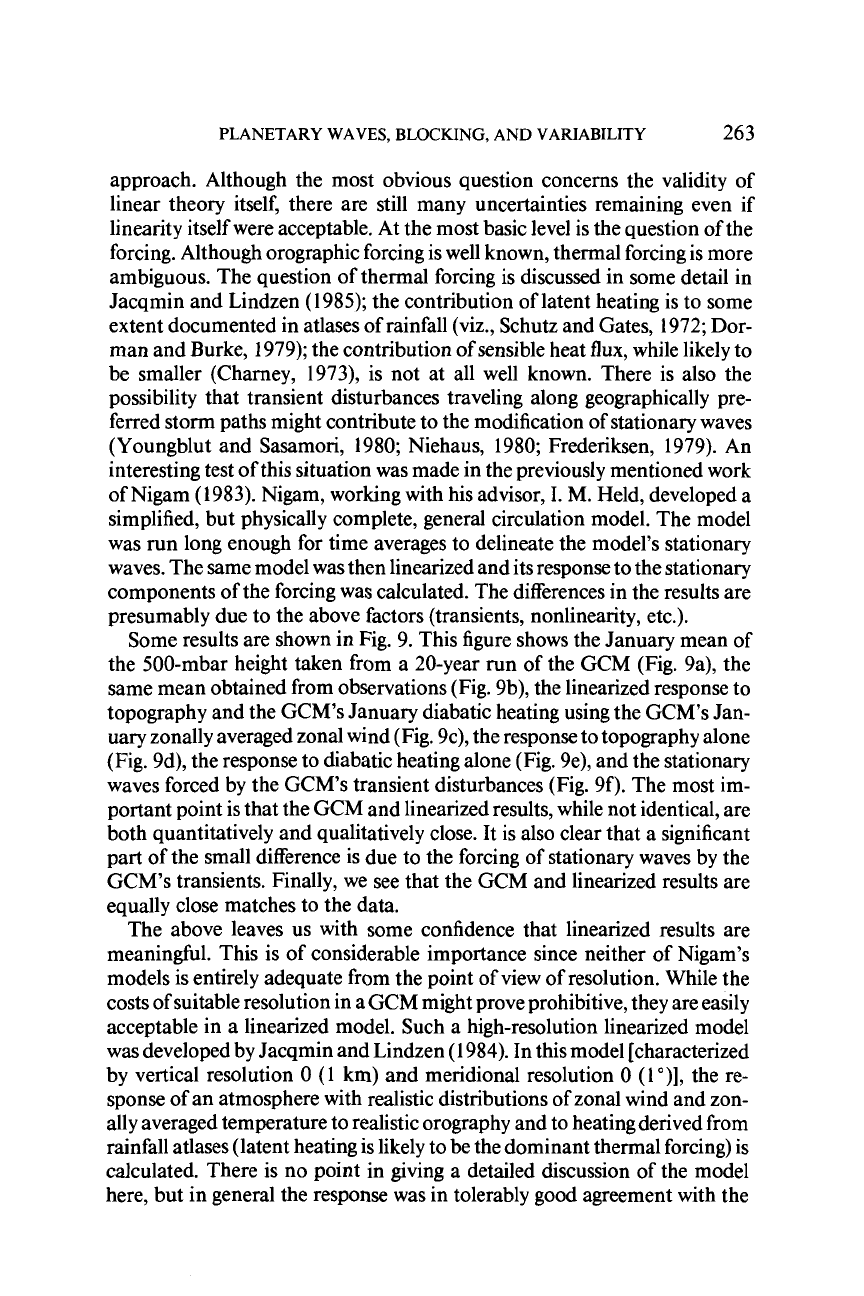
PLANETARY WAVES, BLOCKING, AND VARIABILITY
263
approach. Although the most obvious question concerns the validity of
linear theory itself, there are still many uncertainties remaining even if
linearity itself were acceptable. At the most basic level is the question of the
forcing. Although orographic forcing is well known, thermal forcing is more
ambiguous. The question of thermal forcing is discussed in some detail in
Jacqmin and Lindzen (1985); the contribution of latent heating is to some
extent documented in atlases of rainfall (viz., Schutz and Gates, 1972; Dor-
man and Burke, 1979); the contribution
of
sensible heat flux, while likely to
be smaller (Charney, 1973), is not at all well known. There is also the
possibility that transient disturbances traveling along geographically pre-
ferred storm paths might contribute to the modification of stationary waves
(Youngblut and Sasamori, 1980; Niehaus, 1980; Frederiksen, 1979). An
interesting test of this situation was made in the previously mentioned work
of Nigam (1983). Nigam, working with his advisor,
I.
M. Held, developed a
simplified, but physically complete, general circulation model. The model
was run long enough for time averages to delineate the model’s stationary
waves. The same model was then linearized and its response to the stationary
components of the forcing was calculated. The differences in the results are
presumably due to the above factors (transients, nonlinearity, etc.).
Some results are shown in Fig. 9. This figure shows the January mean of
the 500-mbar height taken from a 20-year run of the GCM (Fig. 9a), the
same mean obtained from observations (Fig. 9b), the linearized response to
topography and the GCM’s January diabatic heating using the GCM’s Jan-
uary zonally averaged zonal wind (Fig. 9c), the response to topography alone
(Fig. 9d), the response to diabatic heating alone (Fig. 9e), and the stationary
waves forced by the GCM’s transient disturbances (Fig. 9f). The most im-
portant point is that the GCM and linearized results, while not identical, are
both quantitatively and qualitatively close. It is also clear that a significant
part of the small difference is due to the forcing of stationary waves by the
GCM’s transients. Finally, we see that the GCM and linearized results are
equally close matches to the data.
The above leaves us with some confidence that linearized results are
meaningful. This is of considerable importance since neither of Nigam’s
models is entirely adequate from the point of view of resolution. While the
costs of suitable resolution in a GCM might prove prohibitive, they are easily
acceptable in a linearized model. Such a high-resolution linearized model
was developed by Jacqmin and Lindzen
(1
984). In this model [characterized
by vertical resolution
0
(1 km) and meridional resolution
0
(1
‘)I,
the re-
sponse of an atmosphere with realistic distributions of zonal wind and zon-
ally averaged temperature to realistic orography and to heating derived from
rainfall atlases (latent heating
is
likely to be the dominant thermal forcing) is
calculated. There is no point in giving a detailed discussion of the model
here, but in general the response was in tolerably good agreement with the
